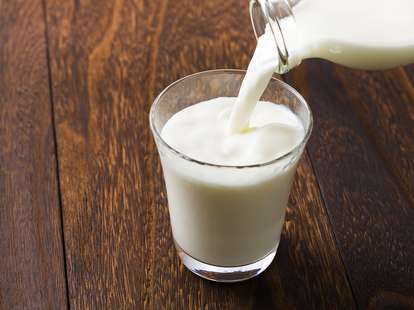How Can I Sweeten Whole Milk to My Baby
Why Whole Milk Is the Superior Dairy Milk
Go ahead and toss the skim.

NaturalBox/Shutterstock
Back in the day, your ancestors used to enjoy fresh, creamy, delicious milk straight from the udder. They also kept coming up with great ideas for other foods to make out of milk, like butter, cheese, and ice cream.
More recently, dairy scientists had another spectacular idea: low-fat milk! Fat's bad, right? By extension, low-fat milk—2%, 1%, and skim—was supposed to be better for us. Even more recently every one became obsessed with almond, oat, cashew, and other various nut milks, but that's another discussion for another day (or another article).
We're here to talk dairy, and the notion that taking the fat out of dairy milk makes it healthier turned out to be a bunch of bullshit, or cowshit, in this case.
Where does skim milk come from, anyway?
It's still coming from cows, don't worry. But there are a few steps with long names between the cow and the consumer: pasteurization, homogenization, and separation. Some people argue that we should skip all of these and campaign for hippie-friendly "raw milk." You can think of it as trendy, or you can acknowledge that when you skip the pasteurization and homogenization, you're really getting something that's potentially disease-causing and lumpy—whatever floats your boat.
Separation is a little different, though. Milk producers take the cream out of the milk, then put some of it back in, depending on what label you want to stick on the carton. For skim milk, your dairy producer literally skims the cream off the top and leaves it out, whereas with 1% or 2% milk they're taking it out and adding some back in until it's 1% or 2% of the total volume. Yep, there's probably an ACT math problem for this.
"Whole" milk sounds like it's full of cream, but it's actually just over 3% fat—dairy producers probably just leave that off the bottle for fear that grocery shoppers will get confused with so many numbers.
Drinking full-fat milk doesn't actually give you heart disease.
Skim milk's journey from pig fattener to health food
Despite the obvious post-World War II connection to fat- and health-conscious consumers, skim milk was actually around much earlier as a byproduct of butter production. Rather than making its way into the homes of average Americans, though, it was more commonly used as a feed to fatten pigs for market, which is kind of gross.
As Kendra Smith-Howard explains in Pure and Modern Milk, World War II came along and increased the demand for powdered skim milk. Like any good war-fueled industry with loads of extra product on its hands after the conflict ends, the dairy producers found ways to sell their goods: they convinced doctors to recommend reduced-fat milk, and who doesn't enjoy a good doctor recommendation?
So, Eisenhower-era Americans and beyond were given a few choices: drink white-colored water and be really healthy, drink creamy goodness the way our forefathers did and get heart disease, or take a middle-of-the-road approach by drinking milk that tastes OK and might be a little bit bad for your health.
The only problem with this logic is that drinking full-fat milk doesn't actually give you heart disease. It's a misguided, vestigial notion that dates back to those days when fat—especially the saturated fat in animal products like milk—was to blame for all the chronic diseases people seemed to be acquiring, like obesity, heart disease, and diabetes. Strangely, the whole milk that had been around for centuries had never caused heart disease before, but it sounded like a good hypothesis anyway.

Whole milk might actually be linked to less obesity
Milk wasn't the only victim of the low-fat craze, which in general didn't do waistlines any favors. Some scientists in Sweden decided to get to the bottom of the milk misconceptions. They looked at the kind of dairy that 1,500 men had in their diets and were amazed to see that the dudes who didn't eat any butter and chose low fat were 50% more likely to develop a central obesity (essentially, a beer belly), while those who ate butter and drank whole milk were 50% less likely to get a gut, compared to men whose diets were in the middle. Central obesity is actually a really important measure, too, because it's strongly associated with cardiovascular disease and diabetes.
What could explain these crazy results? After all, whole milk doesn't just have more fat; it also has almost twice as many calories. However, whole milk also makes you more satiated, and when you get those calories from fat, you may not be getting them from carbs—which have recently stolen the show when it comes to cardiovascular disease.
Fat packs in the good stuff
Whole milk also contains a bunch of vitamins: A, D, E, and K. These particular vitamins are fat soluble, which means that your body absorbs them when they enter your digestive tract together with fat. In milk, the vitamins and the fat come in one nutritious package—Mother Nature knows what's up. When milk producers take out the cream, the vitamins come out with it, too, so they throw some supplements back in and call it a day. But these aren't the same natural vitamins coming from cows.
You now have several good reasons to stop pretending that you actually like the taste of skim milk, or any of its reduced-fat brethren. Go for the good stuff. If you're not lactose intolerant, it might just be even better for you.
Want more Thrillist? Follow us on Instagram, Twitter, Pinterest, YouTube, TikTok, and Snapchat.
Marina Komarovsky is a freelance writer for Thrillist, and she uses all this as an excuse to eat more ice cream. For more on nutrition, follow her tweets: @MariKomarovsky.
How Can I Sweeten Whole Milk to My Baby
Source: https://www.thrillist.com/health/nation/the-difference-between-whole-skim-1-and-2-milk
0 Response to "How Can I Sweeten Whole Milk to My Baby"
Post a Comment